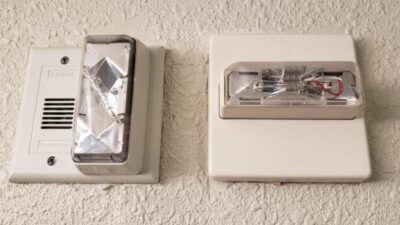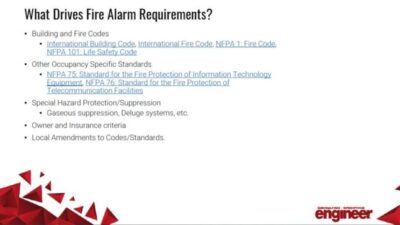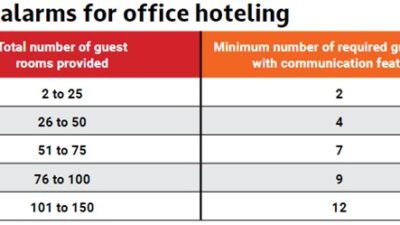CONSULTING-SPECIFYING ENGINEER: Do fire-protection engineers look more to active techniques? How can passive fire protection play a greater role? HAYNES/PRYMAK: The National Fire Protection Assn. (NFPA)—and all the building codes—continue to stress active fire protection in the form of sprinklers and alarm and detection systems.
CONSULTING-SPECIFYING ENGINEER: Do fire-protection engineers look more to active techniques? How can passive fire protection play a greater role?
HAYNES/PRYMAK : The National Fire Protection Assn. (NFPA)—and all the building codes—continue to stress active fire protection in the form of sprinklers and alarm and detection systems. Fire-alarm systems have a proven record, and active smoke control and sprinkler systems can extend the available egress time, minimize smoke and actively suppress or extinguish a fire.
With more challenging designs, it becomes critical for the fire-protection engineer to consider the interaction between the various active and passive schemes employed in the overall building design. This can be especially difficult, because it requires good communication and coordination between electrical, mechanical and structural disciplines.
MADDEN : It’s common for us to look to active techniques. But more than other members of the design team, fire protection engineers try to balance active and passive fire suppression. The either/or framework of prescriptive building codes has created the mindset that a building can have one or the other. Why pay for both if the code says the facility doesn’t need both? To properly address the fire-protection and other life-safety goals and objectives, both active and passive protection schemes need to be assessed. When properly evaluated from a performance standpoint, it is possible to achieve a balance.
Too many times the argument for or against active or passive fire protection schemes has come down to one of reliability. Active systems often have the reputation that since they are “active,” they are somehow less reliable than the passive protection provided by building and structural components. That is certainly not the case. Passive protection schemes have reliability issues to consider, as well. For example, penetrations in fire walls, fire doors that are damaged or blocked open, and structural fireproofing that is damaged or displaced call into question the reliability of these systems.
HAYNES/PRYMAK : Firestopping specification has often been loose, often being vague or not assigned in the installation instructions given to piping contractors. Additionally, some specifications, although assigning the firestopping in a dedicated section, have been unclear with regard to all of the penetrations to be sealed.
MADDEN : Also, building engineers, architects and authorities having jurisdiction have been put into a position of accepting firestopping compounds whose requirements vary by manufacturer, making their knowledge of all of the manufacturers’ requirements extremely difficult.
CSE: Has performance-based design affected the balancing of active and passive techniques?
MARRION : Taking a performance-based design approach, the process really starts with identifying objectives, performance criteria and credible design fire scenarios. This design approach helps all the stakeholders gain a much better and more comprehensive understanding of the level of performance that active and passive systems can provide for a specific design under a variety of scenarios. It also allows one to consider other critical aspects not typically addressed in code-based design, such as reliability, maintainability, life-cycle costs and cost-benefit issues. In addition, performance-based design allows for evaluation of the effects of failure so that issues may be addressed with engineering or management solutions during the design process.
MADDEN : Under various fire scenarios selected in the performance-based approach, the practitioner needs to consider the benefits and limitations of both active and passive systems. Balance is not necessarily providing redundancy for the sake of redundancy, but rather it is the selection of appropriate protection measures based upon desired performance. Also, products and technologies may find acceptance more readily in a performance rather than prescriptive environment.
CSE: How common is performance-based design?
HAYNES/PRYMAK : For the vast majority of conventional building construction projects, most fire protection designs will continue to reflect a more prescriptive approach. Performance-based designs are being employed primarily in nonstandard buildings where unique architectural, occupancy or fire-load requirements contribute to a higher level of perceived risk and make relying upon prescriptive approaches questionable.
In any case, performance-based designs require the engineer to have a better understanding of how the components of an active system work because parameters such as the response time of a smoke detector or a sprinkler head may be required for accurate computer modeling of fire, smoke and egress.
In practice, performance-based designs appear to result in more active protection elements than would be found in prescriptive-based designs, thereby enabling the end user to gain additional value from a desired nonstandard use of the building.
Performance-based designs have also driven suppliers of fire-protection systems to introduce new technologies that better meet more demanding requirements. For example, increased fire loads in warehouses are now being met with performance-based sprinklers capable of protecting storage heights up to 40 ft. And this is possible without the need to add sprinklers within the racking arrangements. Water supply is reduced and additional in-rack sprinklers, valves and piping are eliminated. Such technology results in more economical installations while providing improved fire protection.
CSE: What other kinds of factors may affect these designs in the future?
MARRION : Consideration of additional threats beyond fire, such as chemical/biological attacks and explosions, will affect the overall building design and selection of passive and active fire-protection systems. A multi-hazard approach will allow a better understanding of the overall building performance. Developments in modeling, including egress, fire/smoke and fire/structures interaction are also enhancing understanding of the performance of fire-protection, structural and building systems so they can be designed to address appropriate hazards. Also, a lot of work is underway to better understand the performance of fireproofing materials and structural elements when exposed to fires.
Another factor that may steer a design toward the use of either active or passive systems is the impact of the fire-protection system on the overall sustainability goal of the project.
CSE: What recent changes, or discussion of changes to NFPA codes might affect the specification of sprinklers, piping, alarms and/or firestopping?
HAYNES/PRYMAK : One noteworthy change in NFPA 72 is the requirement that voice-evacuation systems be intelligible. Designing for intelligibility is more involved than designing a simple audible horn tone. System suppliers are working to provide the design and measurement tools needed by engineers to accommodate this requirement.
MARRION : For detection and alarm systems, requirements that performance metrics be provided for individual heat and smoke detectors may be introduced. This will allow one to better understand detector response characteristics to different types of fires, smoke or other fire signatures so that detectors can be appropriately selected, spaced and designed to detect fires of particular sizes and smoke production characteristics more accurately.
MADDEN : Recent fire incidents have resulted in proposed changes. For example, the nightclub fire in Rhode Island early last year brought a call for increased protection in such facilities. It is also anticipated that upcoming changes in some documents will soon reflect the many lessons learned from the World Trade Center.
CSE: What are some notable improvements in sprinkler, piping, alarm and firestopping technology?
MADDEN : The research and development that has occurred, and is occurring, in the sprinkler industry has brought new fire suppression and control technologies to the fire-protection engineer’s toolbox. This research has further refined our understanding of detection and suppression mechanisms, and how these systems affect our overall building performance.
MARRION : In recent years, fire-detection systems have been moving toward incorporating decision logic and multi-criteria sensors, such as smoke and heat or CO 2 detection, which helps to reduce false alarms by requiring more than one fire signature be present. This is in addition to self-adjusting/correcting technology to help limit nuisance alarms, as well as integrating systems with building management and security systems.
Sprinkler improvements exist in terms of further refinements to modeling fire and sprinkler interaction, broader implementation of QRS [quick-response sprinklers] and further research regarding water mist systems.
Research is also underway to achieve a better understanding of the performance of fireproofing materials and structural elements when exposed to fire. This includes development of models, revisiting test methods and development of new technologies and materials. Materials are also starting to be tested for performance regarding adhesion and response to hydrocarbon fire curves.
HAYNES/PRYMAK : Fire alarm and detection systems have improved on many fronts. Smoke detection technology has advanced with dramatic reductions in both the time required to detect a fire and susceptibility to nuisance alarms. By incorporating advanced microprocessors, software and networking technology, fire panels can monitor thousands of points while providing extremely fast response to alarm conditions. Reliability and survivability of detection and alarm systems have also improved. Systems can continue to function even when partially damaged or destroyed by an advancing fire.
Fire-alarm systems are now capable of providing more useful information to the fire services during an event and helping building owners test and maintain the systems properly. Some fire alarm suppliers are recognizing the need to make their new systems backward compatible with older generation equipment. This will allow the end user to upgrade their older systems in stages rather than replace them completely.
Extended coverage sprinklers for high hazard area/density applications now permit the installing contractor to increase the sprinkler spacing from the traditional maximum of 100 sq. ft. per sprinkler to 196 sq. ft. This has resulted in fewer sprinklers for a given installation and allows the contractor to take advantage of reduced operating pressures and reduce costs.
CSE: All this talk of controls brings to mind greater industry efforts to integrate multiple building systems. What’s happening there?
HAYNES/PRYMAK : Integrated control systems that link fire alarm systems with sprinkler, HVAC, security, public address and other building systems have already established a strong presence in the market. One of the driving forces behind integration is an end user seeking improved accountability and cost control by having a single source provider for testing, servicing and equipment upgrading for multiple building systems.
The implication is that fire-protection engineers will be required to know more about the additional functions and operational characteristics of the systems being integrated. For example, if the owner desires an integrated voice evacuation and public address system, the engineer may decide to upgrade to speakers with better frequency response.
MARRION : Coupled with fire effects modeling and wireless technology, integrated building control systems may one day be able to to detect a fire, monitor smoke spread and activate systems as necessary, while reporting in real time to the responding fire department. With such a system, the fire department would be better able to inform their fire ground tactics and evacuation and rescue operations. Security measures may also compete with egress objectives and need to be carefully coordinated.
MADDEN : I agree that as the industry’s experience increases, acceptance of integrating fire-protection and life-safety systems with other building system controls should also increase. However, the balance between using available technological capabilities and keeping it simple from an operational and reliability standpoint will continue to be a challenge for all stakeholders.
(For more information on the topic of balancing active and passive fire-protection, two valuable white papers are available at www.csemag.com . Click the red “Fire” bar on the left.
The U.S. Experience with Sprinklers
| Property Use | Percentage of fires with sprinklers1 | Percentage of fires where sprinklers operated2 | Percentage of fires where sprinklers didn’t operate |
| Public Assembly | 23.0 | 73.9 | 26.1 |
| Educational | 21.6 | 79.6 | 20.4 |
| Health Care & Correctional | 51.2 | 80.0 | 20.0 |
| All Residential | 2.6 | 84.6 | 15.4 |
| 1&2 Family | 0.7 | 80.0 | 20.0 |
| Apartments | 6.6 | 82.7 | 17.3 |
| Hotels & Motels | 32.8 | 82.7 | 17.3 |
| Department Stores | 52.0 | 84.9 | 15.1 |
| Offices | 24.2 | 80.6 | 19.4 |
| Industrial | 12.6 | 85.9 | 14.1 |
| Manufacturing | 49.8 | 91.1 | 8.9 |
| Storage | 3.0 | 84.0 | 16.0 |
| Average Percentages | 23.3 | 82.7 | 17.3 |
| 1 Estimated as percentages of structure fires with sprinklers present divided by the number of structure fires with sprinkler status known. | |||
| 2 Excludes fires where sprinkler was present but fire was coded as too small to test operational status of sprinklers. | |||
| Source: NFPA Report, U.S. Experience with Sprinklers, September 2001. National estimates based on 1989-1998 NFIRS and NFPA survey. | |||
Participants
John Haynes , Director of Marketing, SimplexGrinnell, Westminster, Mass.
Thomas Prymak , Vice President of Marketing, Tyco Building & Fire Products, Lansdale, Pa.
Michael J. Madden , P.E., Principal, Gage-Babcock & Assocs., La Palma, Calif.
Christopher Marrion , P.E., Fire Strategist, Associate Principal, Arup, New York



